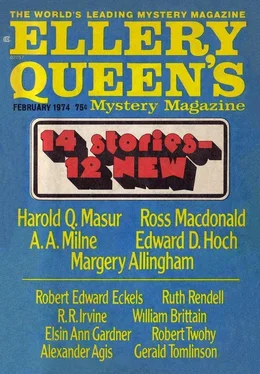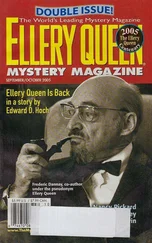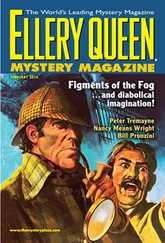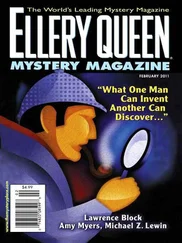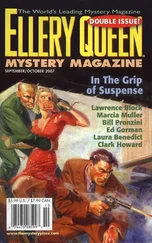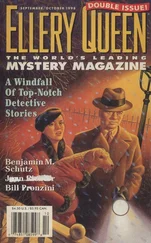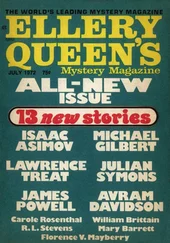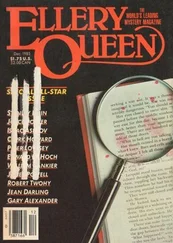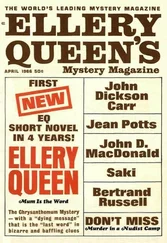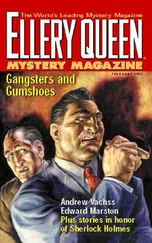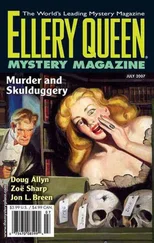Alexander Agis - Ellery Queen’s Mystery Magazine, Vol. 63, No. 2. Whole No. 363, February 1974
Здесь есть возможность читать онлайн «Alexander Agis - Ellery Queen’s Mystery Magazine, Vol. 63, No. 2. Whole No. 363, February 1974» весь текст электронной книги совершенно бесплатно (целиком полную версию без сокращений). В некоторых случаях можно слушать аудио, скачать через торрент в формате fb2 и присутствует краткое содержание. Город: New York, Год выпуска: 1974, Издательство: Davis Publications, Жанр: Классический детектив, на английском языке. Описание произведения, (предисловие) а так же отзывы посетителей доступны на портале библиотеки ЛибКат.
- Название:Ellery Queen’s Mystery Magazine, Vol. 63, No. 2. Whole No. 363, February 1974
- Автор:
- Издательство:Davis Publications
- Жанр:
- Год:1974
- Город:New York
- ISBN:нет данных
- Рейтинг книги:4 / 5. Голосов: 1
-
Избранное:Добавить в избранное
- Отзывы:
-
Ваша оценка:
- 80
- 1
- 2
- 3
- 4
- 5
Ellery Queen’s Mystery Magazine, Vol. 63, No. 2. Whole No. 363, February 1974: краткое содержание, описание и аннотация
Предлагаем к чтению аннотацию, описание, краткое содержание или предисловие (зависит от того, что написал сам автор книги «Ellery Queen’s Mystery Magazine, Vol. 63, No. 2. Whole No. 363, February 1974»). Если вы не нашли необходимую информацию о книге — напишите в комментариях, мы постараемся отыскать её.
Ellery Queen’s Mystery Magazine, Vol. 63, No. 2. Whole No. 363, February 1974 — читать онлайн бесплатно полную книгу (весь текст) целиком
Ниже представлен текст книги, разбитый по страницам. Система сохранения места последней прочитанной страницы, позволяет с удобством читать онлайн бесплатно книгу «Ellery Queen’s Mystery Magazine, Vol. 63, No. 2. Whole No. 363, February 1974», без необходимости каждый раз заново искать на чём Вы остановились. Поставьте закладку, и сможете в любой момент перейти на страницу, на которой закончили чтение.
Интервал:
Закладка:
“And consider this, Commissioner: last week we celebrated our fourteenth month of the pilot program, and already we have cut burglaries in this state by ninety-seven percent.”
“Ninety-seven?”
“Yes, so you can understand why your visit is so important to us. If we can get the Federal Government behind us, we estimate — our computers estimate, that is — that we can cut the overall crime rate in this country by ninety-five percent in just one year.”
“Well, well,” the Commissioner said. “I’ll certainly do my part. It was a personal favor of the President to give me this post, you know. My brother was a heavy contributor to his campaign. Frankly,” he laughed, “I don’t know a thing about crime. You’ll have to show me.”
“That we will, Commissioner,” Karrick said, his white teeth flashing against the charts. “That we will. Now, if you’ll just step through this door—”
Karrick held the door open, and the Commissioner, wide-eyed in his unassuming innocence, entered another room. Karrick took his handkerchief and quickly wiped his brow, then replaced the handkerchief before the Commissioner noticed. He could already feel the money pouring over his hands, through his fingers. He could envision a mass network of CASES centers all across the country, keeping track of every citizen in the United States. Karrick would show these criminals a thing or two! He would put some teeth into the law!
“Now,” said the Chief Detective, fighting the pounding in his chest, “this is where we keep the summaries of the trends shown on the graphs in the other room.” Commissioner Lusnet looked out over a room exactly like the first one-graphs, lines, clerks. “You’ll note the red line — that’s for burglaries, you remember — is a simple line plotting the highs and lows. It represents the summary of trends.”
Commissioner Lusnet sipped his coffee and nodded his head; it all seemed very complicated to him.
“Now, look here, you’ll note how these green lines show a sharp upturn right here?”
“Yes, yes, they certainly do.”
“That means that there will be an increase in homicide during this time period.”
“My, my.”
“Now, look at these other lines — the blue and yellow ones — and you’ll note that they show a downturn during this same period of time.”
“My goodness!” exclaimed Commissioner Lusnet. “They certainly do!”
“That means that crimes of kidnaping and aggravated assault will show a decrease during this same time period.”
“I see... I see...”
“And all this is due to the efficiency afforded us by the computer,” said Karrick, “Our employees are no longer trained in the ‘police sciences’ as such. Most of them are now computer programers, psychology majors, efficiency experts, and research consultants. You see, Commissioner, we feel that if we can anticipate something, we can prevent it from happening.”
“Yes, I think I’ve heard something like that before.”
“You should have. We’ve got a ten-million-dollar advertising campaign to get the point across. ‘If we can predict something before it occurs, we can stop it.’ ”
“Yes; now I know I’ve heard it.”
Karrick stood back a half step from the Commissioner, and as the Commissioner looked out over the long row of charts and sipped his coffee, Karrick quickly took out his handkerchief and wiped his face again. Why he was sweating so, he didn’t really know. He only knew they had sent this damn simpleton down to find out about his program, a simpleton who didn’t know a red line from a blue one — unless it was pointed out to him that they were of different colors — and he, Chief Detective Karrick, was sweating!
“You see those clipboards the officers are carrying? Each one is a complete profile of a citizen, right down to the tiniest detail. I might add, even to how many sugars he has in his coffee.”
Commissioner Lusnet raised an eyebrow. “For every citizen in this state?”
“For each and every citizen in this state — except Federal officials, of course.”
“Oh,” Commissioner Lusnet said, relieved, “of course.”
“And just think, with the Federal Government behind us, we’ll be able to include every citizen in the whole United States.”
“Yes, I see.”
“Now, take our CASES burglary program — it’s crammed full of facts relating to burglars. How old he is, what triggers him, and what we have to do to stop him. Complete social, psychological, and economic factors — they are all in that program. It’s our most advanced program, and I’m proud of it.”
“I should think so.”
“Then we run a computer match with the profiles and the computer gives us any names with a minimum number of match-points.”
“Match-points?”
“That’s just our way of saying that the computer has matched the profiles with the hypothetical profile of the typical burglar.”
“It staggers the imagination.”
“Only that’s where the real work begins! The officers then take over and match up the profiles with the charts. When an officer gets one that matches a minimum number of points, he takes it into the next room and talks it over with a psychologist member of our staff. At that point we start calling them ‘teams.’ ”
“I had no idea,” Commissioner Lusnet said. “The President had no idea.”
“I certainly hope you’ll tell him for us,” Karrick said. “We need that Federal funding if we’re to make this program really effective.”
“I certainly will.”
They had walked the entire length of the room and stopped before another door. “Are there any other questions?”
“I haven’t asked any yet,” the Commissioner said, surprising himself with the realization. “All this is so-so impressive that I haven’t thought much about questions. But tell me, how do you actually pin all this down to an arrest? How do you get all these figures down to one particular man, one particular crime, one particular time?”
“Ah,” said Karrick, “the one question I’ve been waiting for. And now. Commissioner, the surprise!” And he opened the third door. “Welcome to the inner sanctum of CASES!”
Commissioner Lusnet walked into a room of buzzing activity, a room with at least a thousand desks and several thousand clerks. At each desk sat two people, one in a red coat and the other in a black uniform, discussing something very earnestly. Clerks were coming and going with the clipboards. The rumble of their conversations was almost deafening.
“My God!” exclaimed Commissioner Lusnet. “What is all this costing?”
“Commissioner,” said Karrick, very carefully, “this is the most important room in the whole setup. This is where the psychologist member of the team and the confrontation officer get together and talk about the arrest. This is where the final decision is made to actually make an arrest.”
“You mean that at every desk in this room there is a possible arrest under consideration — at this very moment?”
“That’s it exactly.”
“Why, there must be thousands of them!”
“Of course not all of them will result in actual arrests. We do miss a few. But bear in mind that we have cut the overall crime rate in this state by ninety-five percent.”
Commissioner Lusnet was impressed; here, before his eyes, were possible arrests under consideration! Here was proof that the Crime Authority was working!
“Please step over here,” said Karrick, taking the Commissioner’s elbow and guiding him over to a desk.
“Commissioner Lusnet, this is Crime Psychoanalyst Metts and Confrontation Officer Stiltson. Gentlemen, Commissioner Horace Lusnet of the President’s Commission on Crime.”
Читать дальшеИнтервал:
Закладка:
Похожие книги на «Ellery Queen’s Mystery Magazine, Vol. 63, No. 2. Whole No. 363, February 1974»
Представляем Вашему вниманию похожие книги на «Ellery Queen’s Mystery Magazine, Vol. 63, No. 2. Whole No. 363, February 1974» списком для выбора. Мы отобрали схожую по названию и смыслу литературу в надежде предоставить читателям больше вариантов отыскать новые, интересные, ещё непрочитанные произведения.
Обсуждение, отзывы о книге «Ellery Queen’s Mystery Magazine, Vol. 63, No. 2. Whole No. 363, February 1974» и просто собственные мнения читателей. Оставьте ваши комментарии, напишите, что Вы думаете о произведении, его смысле или главных героях. Укажите что конкретно понравилось, а что нет, и почему Вы так считаете.
